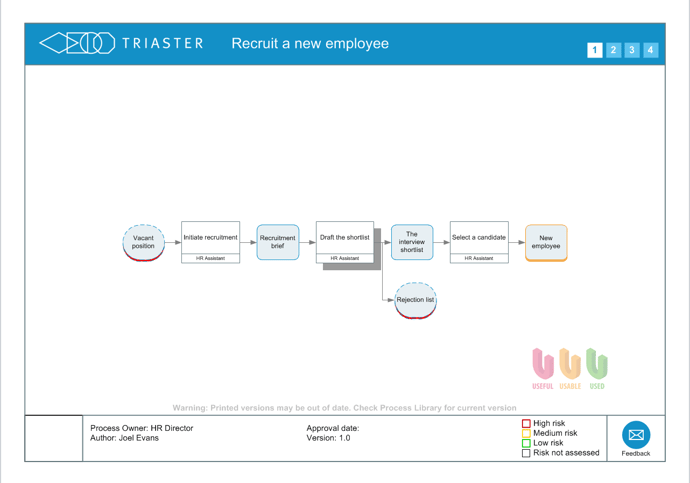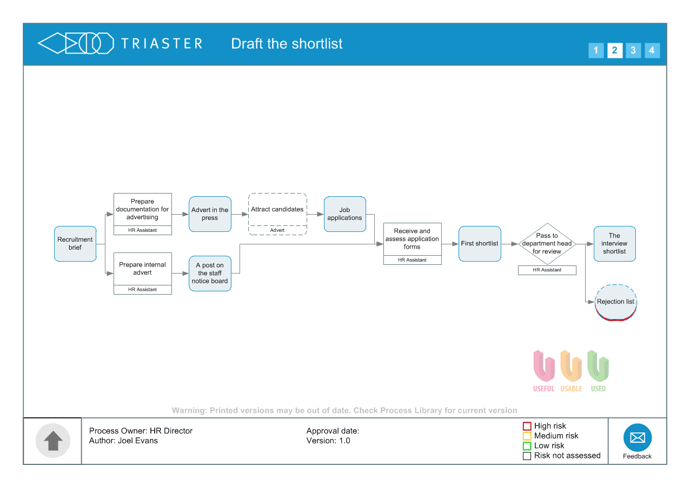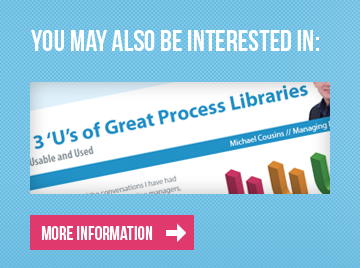I spend the majority of my time with customers, either training on process mapping best practice and software skills, or helping them to map out end to end processes, and I am often asked this question. Detail is very important, and it may be necessary to have your business processes mapped at different levels for different audiences. Here are a few tips I have collected so far in my role as a Project Delivery Consultant at Triaster:
1. Who is your audience? And, what do they want to see?
Process mapping takes up precious time, resource and money, and you want to ensure that what you are creating is relevant for the audience that you are creating it for. If you do not bear this in mind, your process maps will not be utilised. The level of detail that you want to include in your process maps will depend on the audience you are writing for.
If you are creating content for a general ‘how to…’ process library, you want to be creating maps at the level just above work instruction. To do this, ensure you are not including button pushing tasks on the maps. Your end user will likely be looking for a path from start to end with sequential steps outlined telling them ‘what to do’ rather than ‘how to do it’. For example, at this level, an activity could read ‘Update sales system with order details’. Clear and concise. You can then attach the relevant procedure or work instruction to this activity to provide the ‘how to’ detail. Keep it simple and make sure your activities aren’t too wordy, the detail can be kept elsewhere (procedures and work instructions), your process map should be as simple as possible to read and understand.

If you are creating content for an improvement or business analysis library, you may want to map at a lower level of detail than you would for a general ‘how to…’ process library. So, rather than your activity reading ‘Update sales system with order details’ you could drill down in to the detail and outline each of the specific tasks that would be necessary to complete this activity: ‘Open sales system’, ‘Input order number’, ‘Attach purchase order’. In doing this, you are then able to attribute metadata to each individual task (timings, costs).
Always have your intended audience in mind when creating process maps, this will ensure you are delivering what is expected, and that the content is Useful, Usable and Used.
2. Top down or bottom up?
This is a point that I debate frequently with customers; in my experience, the general consensus is that people tend to prefer to write process maps top down. So, start at the very top level, and then drill down in to more detail, time and time again until you are exhausted. However, you may want to consider mapping from the bottom level, and rolling these low level work instruction maps up in to higher level maps. Stay with me for a minute…
If you are mapping top down, your life will become progressively harder and harder as you drill in to more detail time and time again. Whereas, if you start at the bottom level work instruction maps, you get the heavy lifting done straight away, and your life will be getting progressively easier as you roll these maps up into higher level maps. Ensure that your map titles start with a verb and the titles of each of your activities starts with a verb. This makes the ‘rolling up’ of these process maps in to higher level process maps much easier, as the map titles of the lower level maps become the activity names for the next level up.

3. Deliverables
Deliverables are crucial when mapping using Triaster’s preferred Noun/Verb methodology, and are a quick and simple way of explicitly detailing the inputs and outputs for each activity. We believe that activities throughout a process do nothing but attract costs to the organisation. The value is in what is being created or produced, which are the Deliverables. A good way of assessing whether you are mapping at too low a level, is to try to outline the deliverables (outputs) from each activity; so when each activity is complete, what has been produced? If you are struggling to outline this, it would indicate that you are mapping at a lower level of detail than is required.
4. ‘I never finish a painting – I just stop working on it for a while’
Ensure that you know when enough is enough. Our motto here at Triaster is Useful, Usable and Used. You need to ensure that you include enough detail to satisfy the scope of your project and your intended audience, and fulfil the three U’s concept, but when is enough enough? The quote above is from the American Abstract Impressionist Arshile Gorky, and is relevant here as each time you look at a process map, you could:
- Amend it to add more detail
- Change the layout
- Include more information
- Remove information
- Add another level of detail
Related articles:
How to create a process map in 3 simple steps
Written by Joel Evans
Joel joined Triaster in June 2014 and spent several years delivering consultancy and training services on site with customers, helping them to achieve many different business improvement objectives, in many different corners of the world. He left Triaster in November 2016 in order to move back closer to family.

